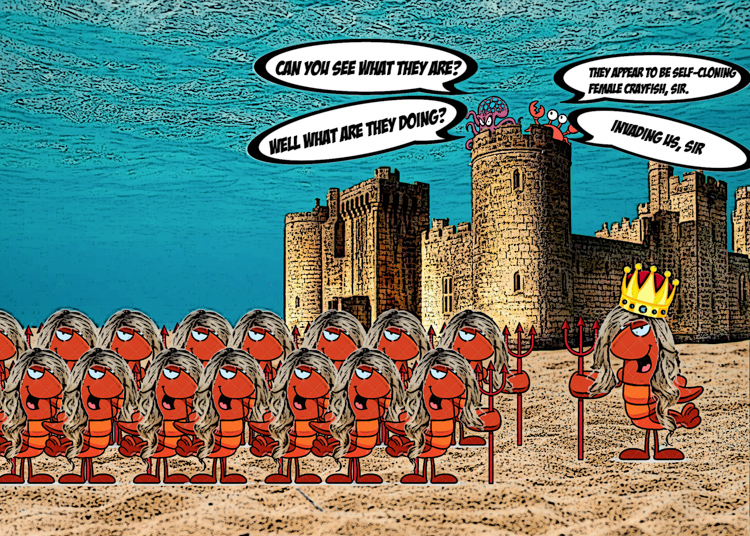
Jessica Gang
At first glance, it reads like the plotline of a bad horror movie: a ten-legged mutant creature is born with the ability to reproduce asexually, manages to escape from captivity in Germany, and within two decades has birthed an entire global population that threatens native species as far from their original population as Madagascar. As bizarre as it seems, this is the origin story of the marbled crayfish.
A recent study published in Nature, Ecology, and Evolution finds that an invasive species of crayfish known as the marbled crayfish has developed a mutation that allows them to reproduce through cloning. As a result, marbled crayfish are multiplying at a rapid pace in Europe, threatening native crayfish species and endangering other wildlife through their sheer numbers.
The first recorded sighting of a marbled crayfish with the cloning mutation was in 1995. The marbled crayfish, which was female, made its way from Florida to an aquarium in Germany, where it proceeded to lay eggs without mating. The crayfish progeny were all female and grew into what appeared to be exact copies of their mother. From there, the species spread at an unprecedented rate, because marbled crayfish are capable of laying hundreds of eggs at a time.
In 2013, Dr. Frank Lyko, a scientist at the German Cancer Research Institute and the head of the study published in Nature, Ecology, and Evolution, was fascinated by the physical similarities between the crayfish and their mothers. With a team of researchers, he embarked on a five year study of the marbled crayfish where he discovered, among other things, that the marbled crayfish is its own separate species and that all marbled crayfish are genetically identical to their mothers.
Lyko hypothesized that the first marbled crayfish was the product of two common slough crayfish native to the Everglades, and a mutation arose in one of the slough crayfish (it’s still unknown if it was the male or the female). Normal sex cells contain one copy of a chromosome, but the mutant sex cell had two. Because of this, the first marbled crayfish had three copies of the sex chromosome instead of the usual two, something that scientists believe enabled the marbled crayfish to create exact copies of itself.
Surprisingly, scientists traced the genealogy of marbled crayfish they found directly back to the original mother. In an interview with National Geographic, Lyko stated that “the scale of this [family] tree is extremely small.” He added that “if we had more than one animal as a founder, we would have greater genetic differences.”
The growth of the marbled crayfish population is becoming a cause of concern for scientists. Marbled crayfish populations were discovered in the Czech Republic, Hungary, Croatia, Ukraine, and Madagascar. On Madagascar in particular, scientists are beginning to fear that the rapid population growth of the marbled crayfish could cause it to drive local species to extinction.
Dr. Lyko’s study has revealed that the marbled crayfish population has spread to cover an area on Madagascar that is the approximate size of Ohio in only a decade, threatening native species that occupy the same ecosystems. The spread of the marbled crayfish population is surprising even to researchers. In an interview with the New York Times published on Feb. 5, Dr. Lyko admitted that “it’s extremely impressive.” He said that “three [researchers] once caught 150 animals within one hour, just with [their] hands.”
Looking to the future, it’s hard to predict what lies in store for the marbled crayfish. There are some large advantages to reproducing asexually, such as always producing fertile offspring, which has contributed to the marbled crayfish’s population explosion.
In the same interview with the New York Times, Dr. Abraham Taylor, a professor at Arkansas University (unaffiliated with the study) said, “asexuality is a fantastic short-term solution” when it comes to cultivating a healthy population. However, offspring that are produced asexually are much more vulnerable to disease than their sexually produced counterparts.
The unique characteristics of marbled crayfish development have allowed scientists who are not marine biologists to draw comparisons between aspects of crayfish development and real-world problems like tumor development. Like marbled crayfish, tumors also evolve through cloning and can adapt to diverse and oftentimes inhospitable environments.
“What we see in slow motion with the marbled crayfish evolution is something that happens during the very early stages of tumor formation,” said Dr. Lyko, according to a National Geographic article. Lyko added that he is “confident the small, invasive crayfish could help them build a model for understanding the early stages of tumor evolution.” Whether or not the crayfish’s fortune changes in the next few decades, the species’ mere existence is a scientific marvel.










